Impact of the Emission Control of Diesel Vehicles on Black Carbon (BC) Concentrations over China
Abstract
1. Introduction
2. Model and Observation Details
2.1. WRF-Chem Model Configuration
2.2. Diesel Vehicles Emission Data
2.3. Numerical Experiments
2.4. BC Measurements
3. Results and Discussions
3.1. Model Validation
3.2. Effect of Diesel Vehicle Emissions on BC
3.3. Sensitivity Experiments and Potential Benefits of the DPF for BC
4. Summary
- Although China implemented stringent emission standards and accelerated the elimination of yellow-label vehicles from 2013 to 2017, the reduction in particulate matter from diesel vehicles was not clearly improved. The annual black carbon emissions of diesel vehicles in 2013 and 2017 were respectively 313,300 T and 269,751 T y−1, corresponding to 19.11 and 19.57 million diesel vehicles.
- Both simulated black carbon from all sources and diesel vehicles in 2017 exhibited specific characteristics in terms of spatial distribution, in which higher BC concentrations are mainly concentrated in densely populated areas. The highest BC concentrations occurred in the large cities of the North China Plain (NCP). For example, in three large NCP cities (Beijing, Tianjin, and Taiyuan), the average observed and simulated black carbon concentrations in 2017 were respectively 8.4 and 8.6 μg·m−3 in Beijing, 9.1 and 10.5 μg·m−3 in Tianjin, and 18.6 and 17.0 μg·m−3 in Taiyuan.
- There are also important seasonal variations of BC concentrations in the NCP. For example, in 2017, the average BC concentration in the NCP was 0.4 μg·m−3 in winter but 0.24 μg·m−3 in summer (July). The ratio between the values for winter and summer was 1.7. However, the BC concentrations in the NCP were profoundly higher in winter than in summer, with a ratio of 3.7. This result suggests that a reduction in diesel vehicle emissions has more benefits for reducing BC pollution not only in winter but also in other seasons.
- The sensitivity studies show that in CASE1 (BC emissions from diesel vehicles reduced by 65%), the average BC concentrations decreased by about ~6% in January and by more than 10% in other seasons. In some regional locations, the highest reductions were greater than 50%. In CASE2 (BC emissions from diesel vehicles reduced by 39%), the average BC concentrations decreased by about ~3.5% in January and by more than 7% in other seasons.
Author Contributions
Funding
Acknowledgments
Conflicts of Interest
References
- Bond, T.C.; Doherty, S.J.; Fahey, D.W.; Forster, P.M.; Berntsen, T.; DeAngelo, B.J.; Flanner, M.G.; Ghan, S.; Kärcher, B.; Koch, D.; et al. Bounding the role of black carbon in the climate system: A scientific assessment. J. Geophys. Res. Atmos. 2013, 118, 5380–5552. [Google Scholar] [CrossRef]
- Andreae, M.O.; Gelencsér, A. Black carbon or brown carbon: The nature of light-absorbing carbonaceous aerosols. Atmos. Chem. Phys. 2006, 6, 3131–3148. [Google Scholar] [CrossRef]
- Samset, B.H.; Myhre, G.; Herber, A.; Kondo, Y.; Li, S.-M.; Moteki, N.; Koike, M.; Oshima, N.; Schwarz, J.P.; Balkanski, Y.; et al. Modelled black carbon radiative forcing and atmospheric lifetime in AeroCom Phase II constrained by aircraft observations. Atmos. Chem. Phys. 2014, 14, 12465–12477. [Google Scholar] [CrossRef]
- Bond, T.C.; Streets, D.G.; Yarber, K.F.; Nelson, S.M.; Woo, J.-H.; Klimont, Z. A technology-based global inventory of black and organic carbon emissions from combustion. J. Geophys. Res. 2004, 109, D14203. [Google Scholar] [CrossRef]
- Bond, T.C.; Bhardwaj, E.; Dong, R.; Jogani, R.; Jung, S.; Roden, C.; Streets, D.G.; Trautmann, N.M. Historical emissions of black and organic carbon aerosol from energy-related combustion, 1850–2000. Glob. Biogeochem. Cycles 2007, 21. [Google Scholar] [CrossRef]
- Jacobson, M.Z. Investigating cloud absorption effects: Global absorption properties of black carbon, tar balls, and soil dust in clouds and aerosols. J. Geophys. Res. 2012, 117. [Google Scholar] [CrossRef]
- Apte, J.S.; Brauer, M.; Cohen, A.J.; Ezzati, M.; Pope, C.A. Ambient PM2.5 Reduces Global and Regional Life Expectancy. Environ. Sci. Technol. Lett. 2018, 5, 546–551. [Google Scholar] [CrossRef]
- Yang, H.-H.; Arafath, S.M.; Lee, K.-T.; Hsieh, Y.-S.; Han, Y.-T. Chemical characteristics of filterable and condensable PM 2.5 emissions from industrial boilers with five different fuels. Fuel 2018, 232, 415–422. [Google Scholar] [CrossRef]
- Ying, Y.; Liu, D. Effects of Flame Configuration and Soot Aging on Soot Nanostructure and Reactivity in n-Butanol-Doped Ethylene Diffusion Flames. Energy Fuels 2018, 32, 607–624. [Google Scholar] [CrossRef]
- Soltani, S.; Andersson, R.; Andersson, B. The effect of exhaust gas composition on the kinetics of soot oxidation and diesel particulate filter regeneration. Fuel 2018, 220, 453–463. [Google Scholar] [CrossRef]
- Grell, G.A.; Peckham, S.E.; Schmitz, R.; McKeen, S.A.; Frost, G.; Skamarock, W.C.; Eder, B. Fully coupled “online” chemistry within the WRF model. Atmos. Environ. 2005, 39, 6957–6975. [Google Scholar] [CrossRef]
- Tie, X.X.; Madronich, S.; Li, G.; Ying, Z.; Zhang, R.; Garcia, A.; Taylor, J.; Liu, Y. Characterizations of chemical oxidants in Meixo City: A regional chemical dynamical model (WRF-Chem) study. Atmos. Environ. 2007, 41, 1989–2008. [Google Scholar] [CrossRef]
- Tie, X.; Madronich, S.; Li, G.; Ying, Z.; Weinheimer, A.; Apel, E.; Campos, T. Simulation of Mexico City plumes during the MIRAGE-Mex field campaign using the WRF-Chem model. Atmos. Chem. Phys. 2009, 9, 4621–4638. [Google Scholar] [CrossRef]
- Li, G.; Bei, N.; Tie, X.; Molina, L.T. Aerosol effects on the photochemistry in Mexico City during MCMA-2006/MILAGRO campaign. Atmos. Chem. Phys. 2011, 11, 5169–5182. [Google Scholar] [CrossRef]
- Stockwell, W.R.; Middleton, P.; Chang, J.S.; Tang, X. The second generation regional acid deposition model chemical mechanism for regional air quality modeling. J. Geophys. Res. 1990, 95, 16343–16367. [Google Scholar] [CrossRef]
- Ackermann, I.J.; Hass, H.; Memmesheimer, M.; Ebel, A.; Binkowski, F.S.; Shankar, U. Modal aerosol dynamics model for Europe. Atmos. Environ. 1998, 32, 2981–2999. [Google Scholar] [CrossRef]
- Schell, B.; Ackermann, I.J.; Hass, H.; Binkowski, F.S.; Ebel, A. Modeling the formation of secondary organic aerosol within a comprehensive air quality model system. J. Geophys. Res. 2001, 106, 28275–28293. [Google Scholar] [CrossRef]
- Iacono, M.J.; Delamere, J.S.; Mlawer, E.J.; Shephard, M.W.; Clough, S.A.; Collins, W.D. Radiative forcing by long-lived greenhouse gases: Calculations with the AER radiative transfer models. J. Geophys. Res. 2008, 113. [Google Scholar] [CrossRef]
- Morrison, H.; Thompson, G.; Tatarskii, V. Impact of Cloud Microphysics on the Development of Trailing Stratiform Precipitation in a Simulated Squall Line: Comparison of One- and Two-Moment Schemes. Mon. Weather Rev. 2009, 137, 991–1007. [Google Scholar] [CrossRef]
- Emmons, L.K.; Walters, S.; Hess, P.G.; Lamarque, J.-F.; Pfister, G.G.; Fillmore, D.; Granier, C.; Guenther, A.; Kinnison, D.; Laepple, T.; et al. Description and evaluation of the Model for Ozone and Related chemical Tracers, version 4 (MOZART-4). Geosci. Model Dev. 2010, 3, 43–67. [Google Scholar] [CrossRef]
- Chen, F.; Dudhia, J. Coupling an advanced land surface-hydrology model with the Penn state-NCAR MM5 modeling system. Part I: Model implementation and sensitivity. Mon. Weather Rev. 2001, 129, 569–585. [Google Scholar] [CrossRef]
- Hong, S.-Y.; Noh, Y.; Dudhia, J. A New Vertical Diffusion Package with an Explicit Treatment of Entrainment Processes. Mon. Weather Rev. 2006, 134, 2318–2341. [Google Scholar] [CrossRef]
- Grell, G.A.; Dévényi, D.A. Generalized approach to parameterizing convection combining ensemble and data assimilation techniques. Geophys. Res. Lett. 2002, 29, 31–38. [Google Scholar] [CrossRef]
- Zhang, Q.; Streets, D.G.; Carmichael, G.R.; He, K.B.; Huo, H.; Kannari, A.; Klimont, Z.; Park, I.S.; Reddy, S.; Fu, J.S.; et al. Asian emissions in 2006 for the NASA INTEX-B mission. Atmos. Chem. Phys. 2009, 9, 5131–5153. [Google Scholar] [CrossRef]
- Li, M.; Zhang, Q.; Kurokawa, J.-I.; Woo, J.-H.; He, K.; Lu, Z.; Ohara, T.; Song, Y.; Streets, D.G.; Carmichael, G.R.; et al. MIX: A mosaic Asian anthropogenic emission inventory under the international collaboration framework of the MICS-Asia and HTAP. Atmos. Chem. Phys. 2017, 17, 935–963. [Google Scholar] [CrossRef]
- Zheng, B.; Huo, H.; Zhang, Q.; Yao, Z.L.; Wang, X.T.; Yang, X.F.; Liu, H.; He, K.B. High-resolution mapping of vehicle emissions in China in 2008. Atmos. Chem. Phys. 2014, 14, 9787–9805. [Google Scholar] [CrossRef]
- Wang, Y.J.; Ji, Z.; Yin, H.; Huang, Z.H.; Ma, D.; Wang, H.L.; Qian, L.Y.; Xie, Q.; Xiao, H. Analysis of black carbon emissions from diesel vehicles in China from 2010–2013. Environ. Dev. Sustain. 2015, 40, 19–21. [Google Scholar]
- Chow, J.C.; Watson, J.G.; Pritchett, L.C.; Pierson, W.R.; Frazier, C.A.; Purcell, R.G. The dri thermal/optical reflectance carbon analysis system: Description, evaluation and applications in U.S. Air quality studies. Atmos. Environ. Part A. Gen. Top. 1993, 27, 1185–1201. [Google Scholar] [CrossRef]
- Chow, J.C.; Watson, J.G.; Chen, L.W.A.; Arnott, W.P.; Moosmüller, H.; Fung, K. Equivalence of elemental carbon by thermal/optical reflectance and transmittance with different temperature protocols. Environ. Sci. Technol. 2004, 38, 4414–4422. [Google Scholar] [CrossRef]
- Cao, J.J.; Lee, S.C.; Ho, K.F.; Zhang, X.Y.; Zou, S.C.; Fung, K.; Chow, J.C.; Watson, J.G. Characteristics of carbonaceous aerosol in Pearl River Delta Region, China during 2001 winter period. Atmos. Environ. 2003, 37, 1451–1460. [Google Scholar] [CrossRef]
- Cao, J.J.; Shen, Z.X.; Chow, J.C.; Watson, J.G.; Lee, S.C.; Tie, X.X.; Ho, K.F.; Wang, G.H.; Han, Y.M. Winter and Summer PM2.5 Chemical Compositions in Fourteen Chinese Cities. J. Air Waste Manag. Assoc. 2012, 62, 1214–1226. [Google Scholar] [CrossRef] [PubMed]
- Li, R.; Han, Y.; Wang, L.; Shang, Y.; Chen, Y.J. Differences in oxidative potential of black carbon from three combustion emission sources in China. J. Environ. Manag. 2019, 240, 57–65. [Google Scholar] [CrossRef] [PubMed]
- Bishop, G.A.; Hottor-Raguindin, R.; Stedman, D.H.; McClintock, P.; Theobald, E.; Johnson, J.D.; Lee, D.-W.; Zietsman, J.; Misra, C. On-Road Heavy-Duty Vehicle Emissions Monitoring System. Environ. Sci. Technol. 2015, 49, 1639–1645. [Google Scholar] [CrossRef]
- Preble, C.V.; Dallmann, T.R.; Kreisberg, N.M.; Hering, S.V.; Harley, R.A.; Kirchstetter, T.W. Effects of Particle Filters and Selective Catalytic Reduction on Heavy-Duty Diesel Drayage Truck Emissions at the Port of Oakland. Environ. Sci. Technol. 2015, 49, 8864–8871. [Google Scholar] [CrossRef]
- Karjalainen, P.; Rönkkö, T.; Simonen, P.; Ntziachristos, L.; Juuti, P.; Timonen, H.; Teinilä, K.; Saarikoski, S.; Saveljeff, H.; Lauren, M.; et al. Strategies to Diminish the Emissions of Particles and Secondary Aerosol Formation from Diesel Engines. Environ. Sci. Technol. 2019, 53, 10408–10416. [Google Scholar] [CrossRef] [PubMed]
- Khalek, I.A.; Blanks, M.G.; Merritt, P.M.; Zielinska, B. Regulated and Unregulated Emissions from Modern 2010 Emissions-Compliant Heavy-Duty on-Highway Diesel Engines. J. Air Waste Manag. Assoc. 2015, 65, 987–1001. [Google Scholar] [CrossRef] [PubMed]
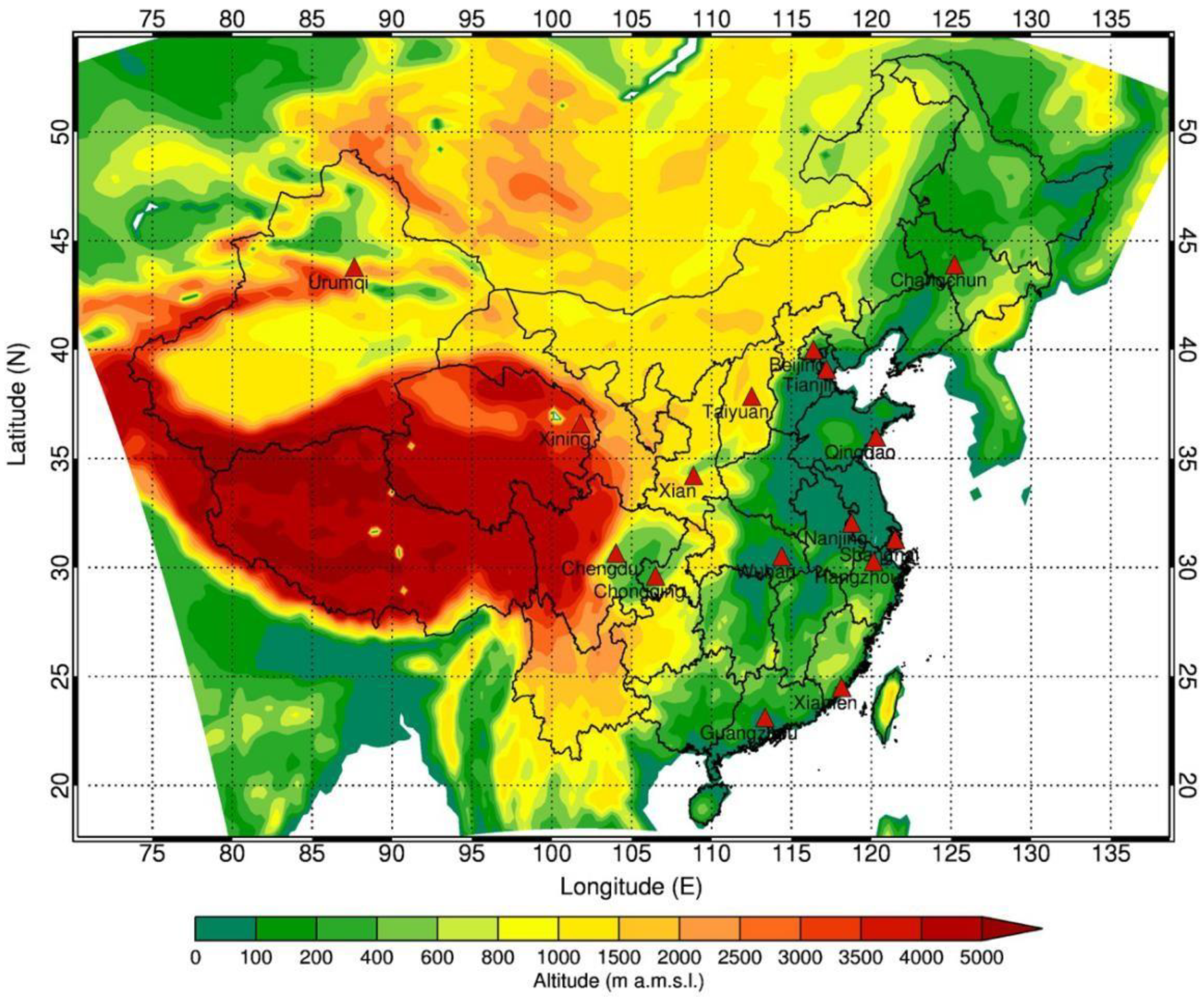
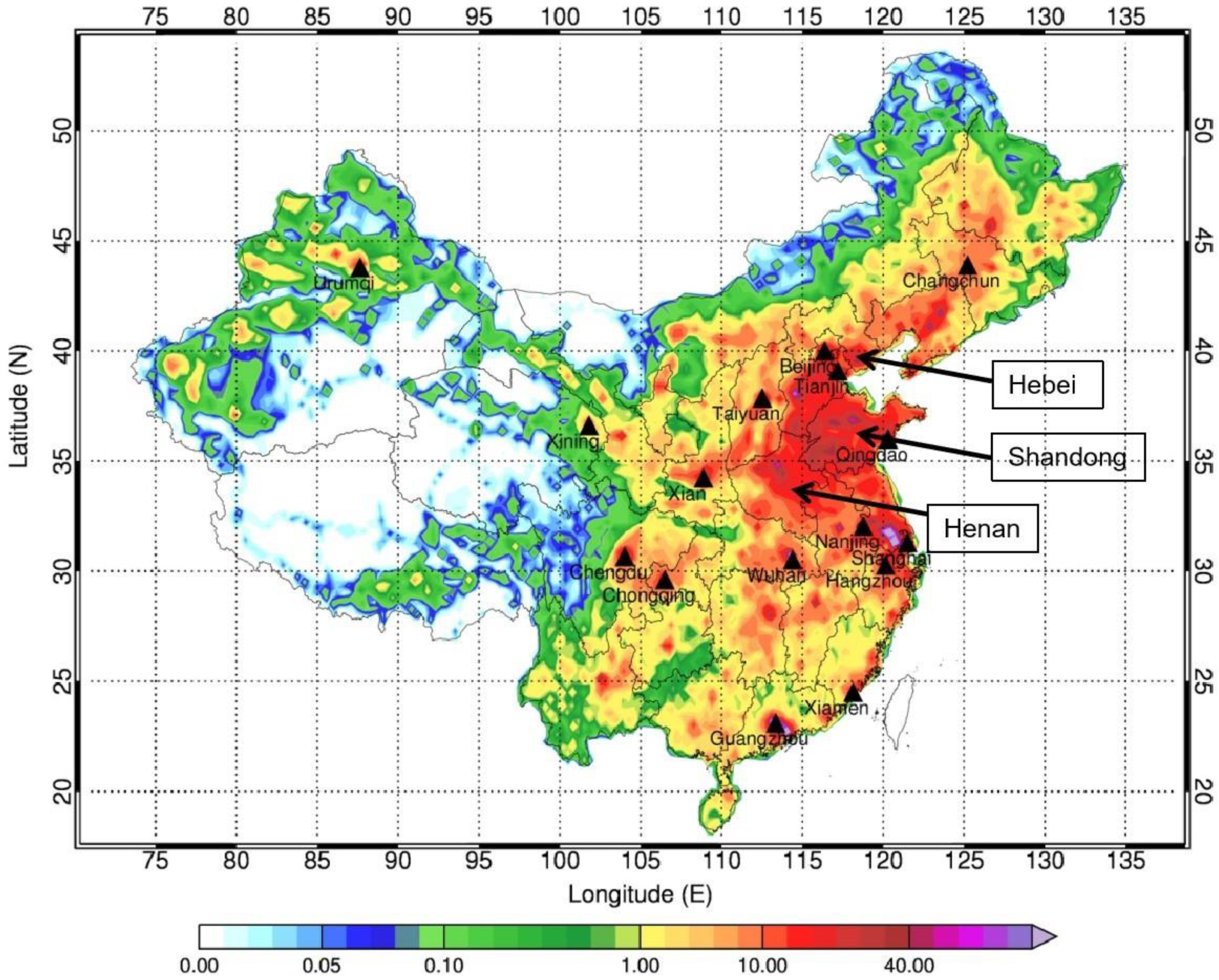
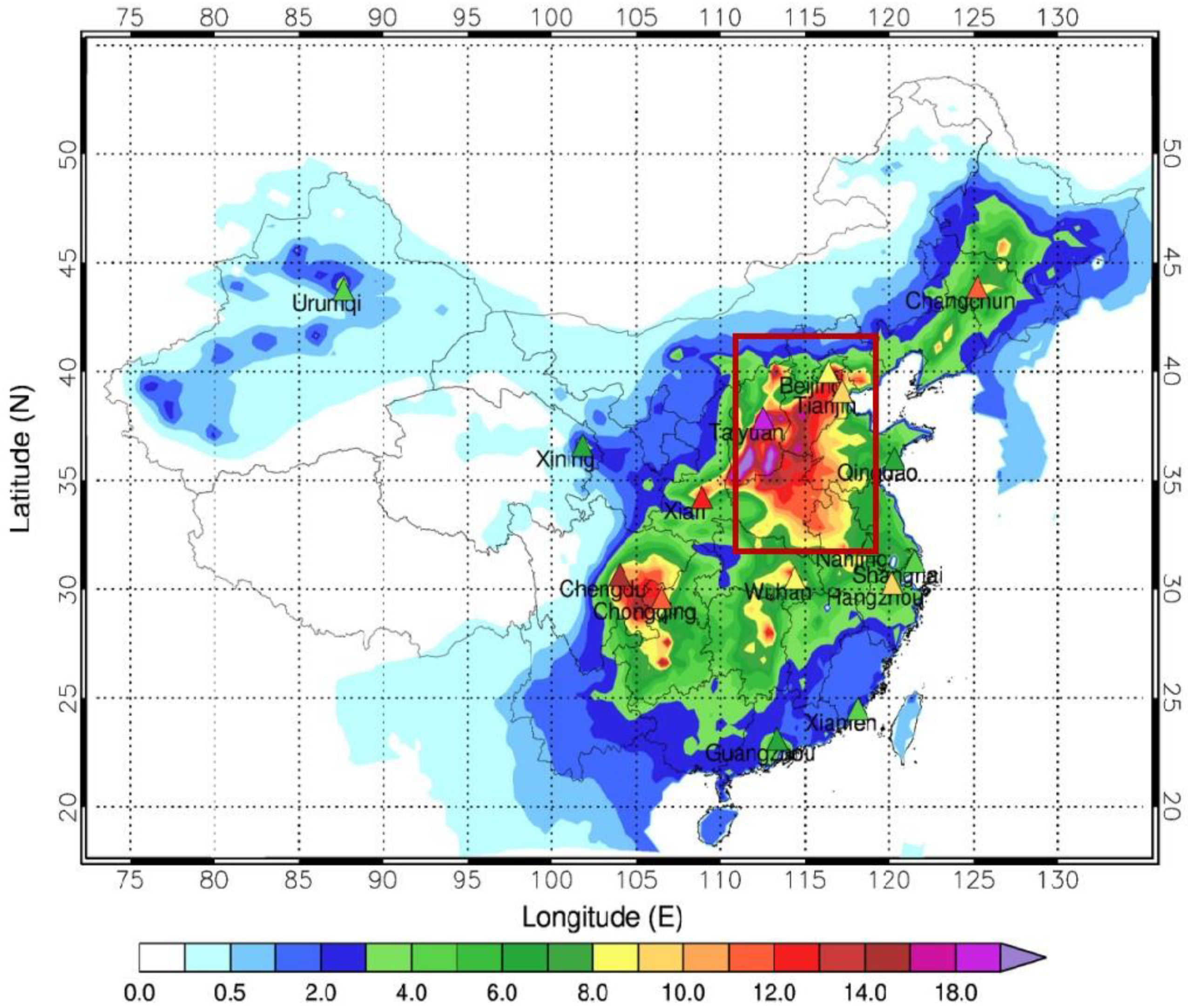
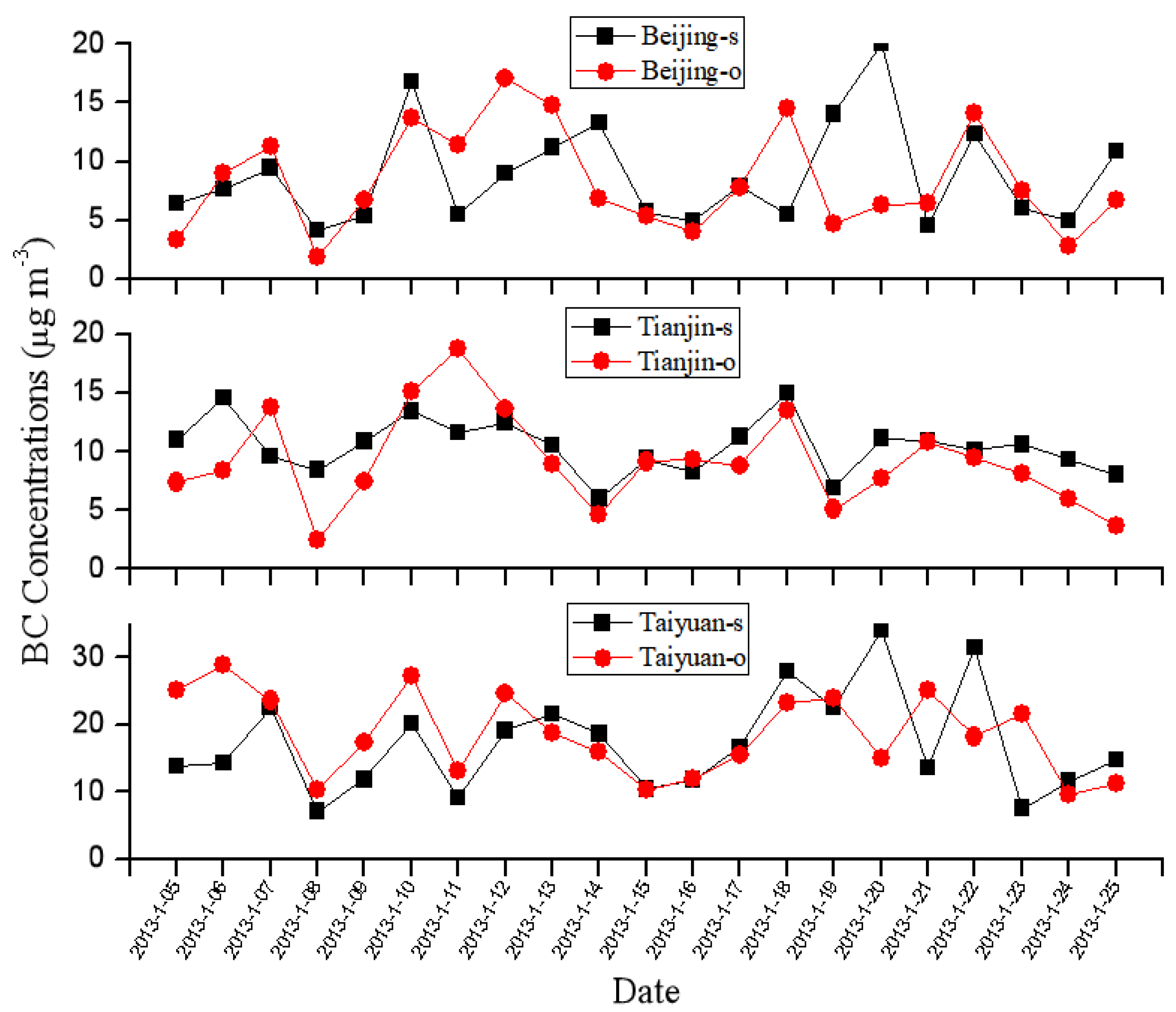
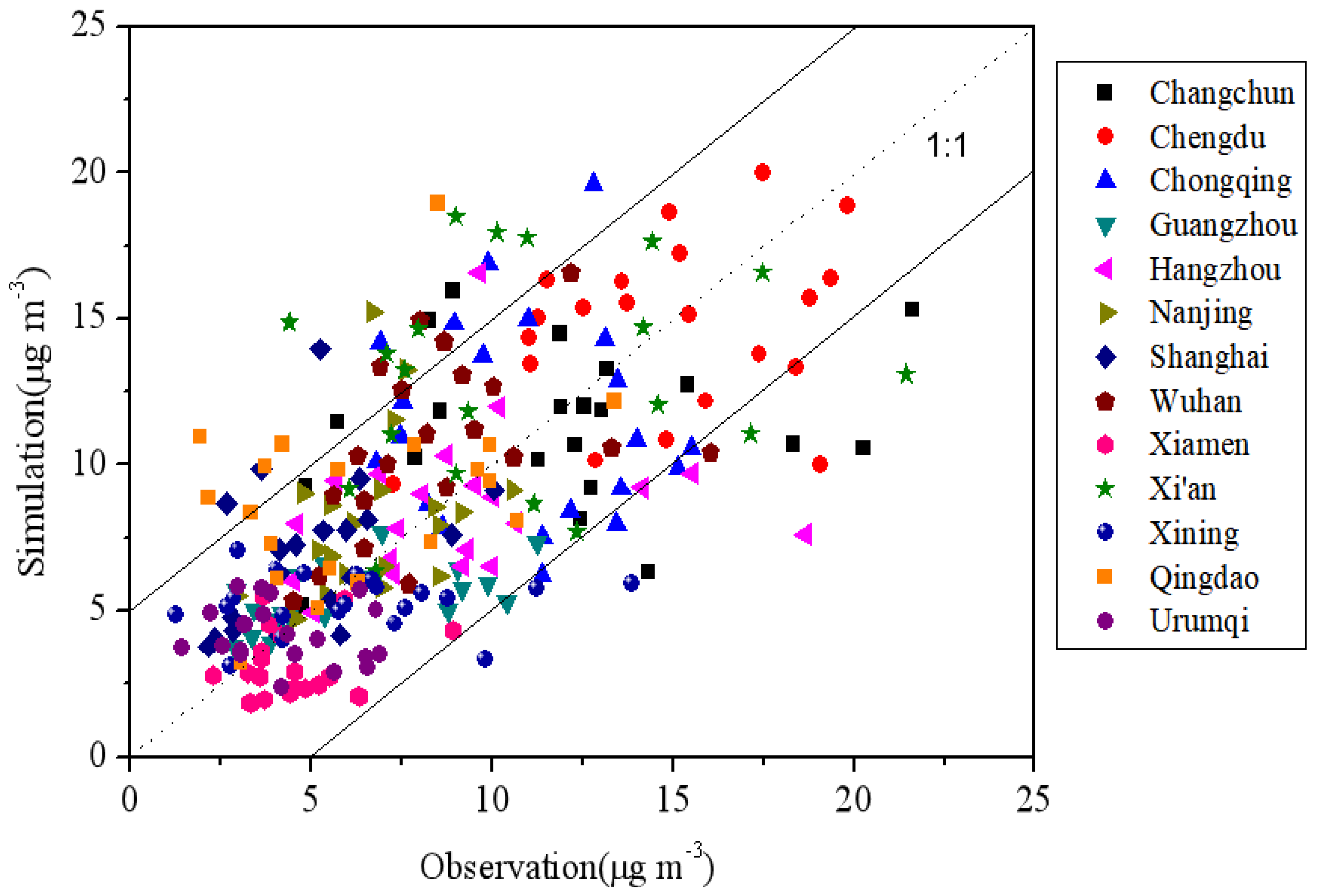
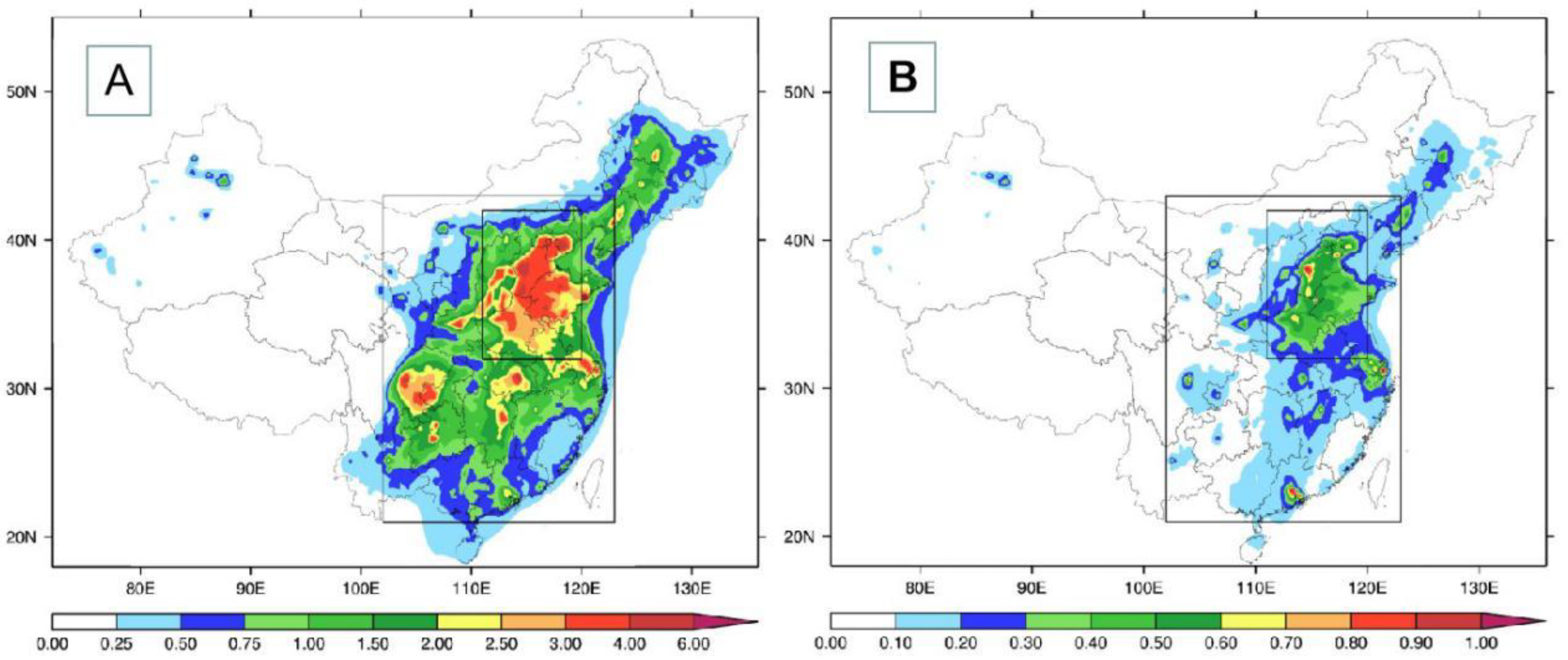
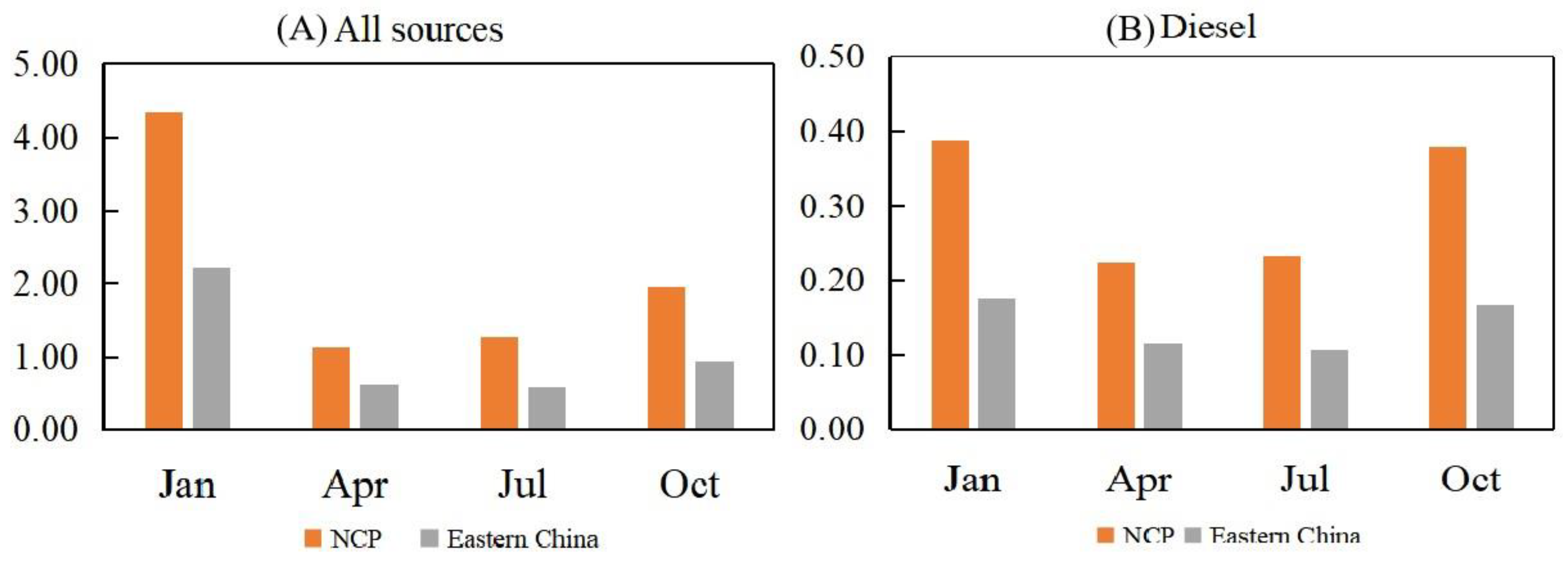
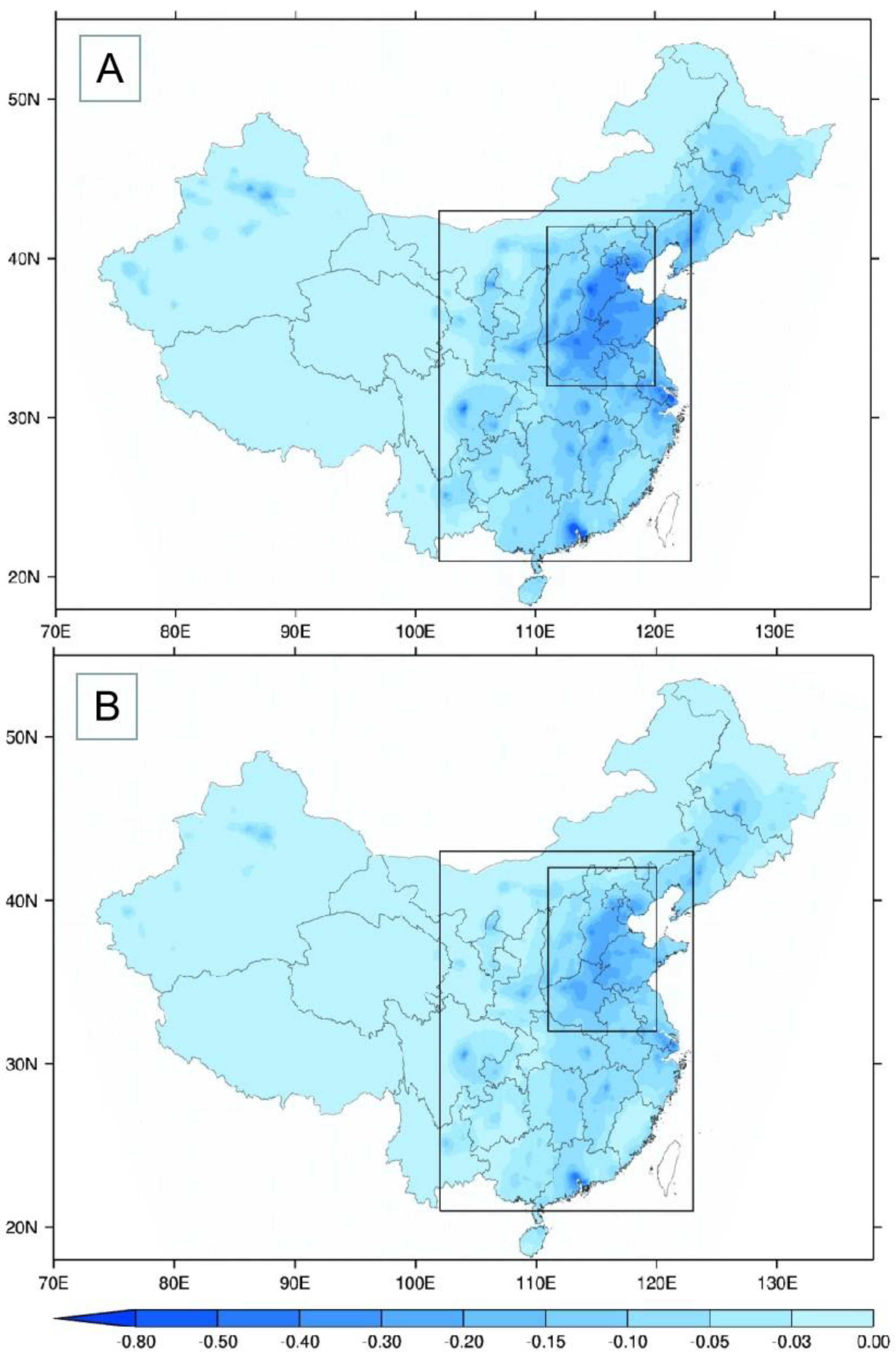
| Model Parameter | Description |
|---|---|
| Number of grid points | 140 × 120 (horizontal) × 35 (vertical) |
| Horizontal grid projection | Lambert |
| Horizontal resolution | 36 km × 36 km |
| Model top | 50 hPa |
| Model domain center | 37° N, 102° E |
| Chemical mechanisms | RADM2 [15]/ MADE-SORGAM [16,17] |
| Meteorological initial and boundary conditions | National Centers for Environmental Prediction, NCEP 1° × 1° reanalysis data http://rda.ucar.edu/datasets/ds083.2/ |
| SW and LW radiation | RRTMG [18] |
| Cloud Microphysics | Morrison double moment [19] |
| Lateral BC boundary condition | MOZART4 6-h output [20] |
| Land surface model | NOAH [21] |
| Planetary boundary layer | YSU scheme [22] |
| Cumulus parameterization | Grell-3d [23] |
| Seasons | Areas | CASE1 (65% Reduction) | CASE2 (39% Reduction) | ||||
|---|---|---|---|---|---|---|---|
| High | Low | Mean | High | Low | Mean | ||
| Jan | NCP | 9.6% | 3.1% | 5.9% | 5.8% | 1.9% | 3.5% |
| Eastern China | 25.5% | 1.0% | 6.2% | 15.3% | 0.6% | 3.7% | |
| Apr | NCP | 17.2% | 6.7% | 12.7% | 10.3% | 4.0% | 7.6% |
| Eastern China | 52.2% | 3.6% | 12.8% | 31.3% | 2.2% | 7.7% | |
| Jul | NCP | 17.2% | 5.7% | 11.9% | 10.3% | 3.4% | 7.2% |
| Eastern China | 52.1% | 3.3% | 12.8% | 31.2% | 2.0% | 7.7% | |
| Oct | NCP | 17.8% | 6.3% | 12.6% | 10.7% | 3.8% | 7.6% |
| Eastern China | 42.7% | 3.1% | 11.9% | 25.6% | 1.9% | 7.2% | |
© 2020 by the authors. Licensee MDPI, Basel, Switzerland. This article is an open access article distributed under the terms and conditions of the Creative Commons Attribution (CC BY) license (http://creativecommons.org/licenses/by/4.0/).
Share and Cite
Zhou, J.; Tie, X.; Yu, Y.; Zhao, S.; Li, G.; Liu, S.; Zhang, T.; Dai, W. Impact of the Emission Control of Diesel Vehicles on Black Carbon (BC) Concentrations over China. Atmosphere 2020, 11, 696. https://doi.org/10.3390/atmos11070696
Zhou J, Tie X, Yu Y, Zhao S, Li G, Liu S, Zhang T, Dai W. Impact of the Emission Control of Diesel Vehicles on Black Carbon (BC) Concentrations over China. Atmosphere. 2020; 11(7):696. https://doi.org/10.3390/atmos11070696
Chicago/Turabian StyleZhou, Jiamao, Xuexi Tie, Yunbo Yu, Shuyu Zhao, Guohui Li, Suixin Liu, Ting Zhang, and Wenting Dai. 2020. "Impact of the Emission Control of Diesel Vehicles on Black Carbon (BC) Concentrations over China" Atmosphere 11, no. 7: 696. https://doi.org/10.3390/atmos11070696
APA StyleZhou, J., Tie, X., Yu, Y., Zhao, S., Li, G., Liu, S., Zhang, T., & Dai, W. (2020). Impact of the Emission Control of Diesel Vehicles on Black Carbon (BC) Concentrations over China. Atmosphere, 11(7), 696. https://doi.org/10.3390/atmos11070696






